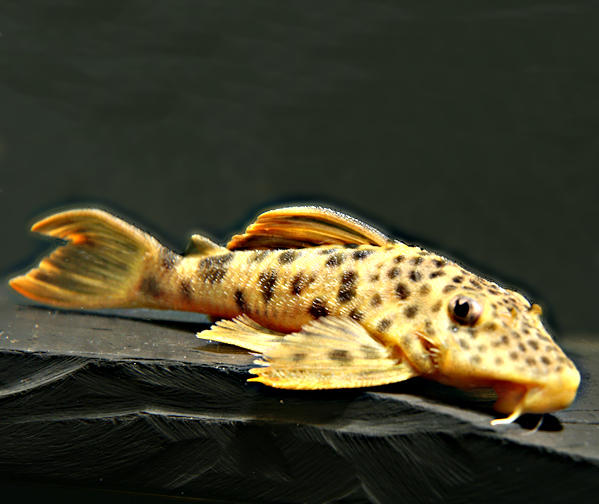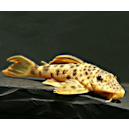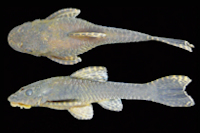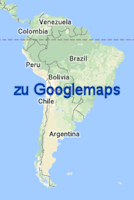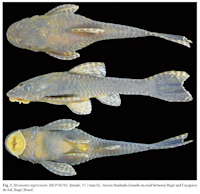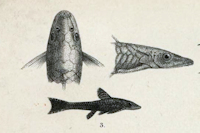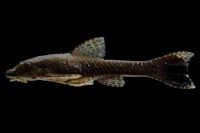nigri (lat.) = scharz, caudal = Schwanzflosse
Synonyme
Cascudinho-da-cola-preta
Microlepidogaster nigricauda
Otocinclus nigricauda
Microlepidogaster nigricauda
Otocinclus nigricauda
nicht gefährdet (Least Concern)
Länge (total)
etwa 5 cm
Standardlänge (dokumentiert)
39,2 mm
Empfohlene Aquariengröße
60 cm
arroio Bebedouro Grande = arroio Banhado Grande, arroio do Brejo, rio Caí, rio Camaquã, arroio Chasqueiro = arroio Xasqueiro, arroio Grande, rio Guaíba, arroio Guará, unbekannter Zufluss zu arroio Hilário, rio Jacuí, arroio Passo da Miséria, arroio Passo dos Carros, arroio Passo dos Ferreiros, arroio Piraí, arroio do Salso, arroio Santa Rita, unbekannter Zufluss zu arroio Seival, arroio do Tigre, arroio Velhaco, rio Cacequi, arroio Caraí-Passo, rio Ibicuí, rio Inhacunda = arroio Inhacunda, rio Santa Maria, unbekannter Zufluss zu rio Toropi, arroyo Batovi, arroyo Corrales, arroyo Cunapiru = arroyo Cuñapiru, arroyo Maestre de Campo, unbekannter Zufluss zu río Negro, ➀ río Uruguay = rio Uruguai, río Cuay Grande = arroyo Cuay Grande, rio Touro Passo
Rio Grande do Sul, Corrientes, Rivera, Durazno
Argentinien, Brasilien, Uruguay
arroio Camaquã Chico ➙ rio Camaquã |
rio Gravataí | rio Vacacaí ⇒ rio Jacuí | arroio Araçá ⇒ rio Guaíba | laguna Merín ➙ canal São Gonçalo | lago Guaraxaim | arroio Velhaco ⇒ lagoa dos Patos ➙ Atlantic SE↓ rio Inhacunda ➙ rio Ibicuí ⇒ Rio Uruguai = río Uruguay ➙ río de la Plata
˜[ -30.488,-51.393 ]
Strömung
wenig
Substrat
Sand
Am Ufer
Gräser
Ernährung (überwiegend): Vegetarier (herbivore)
Frisst Pflanzen
nicht bekannt
Haltung in Gruppen notwendig.
unbekannt
I / 5 Flossenstrahlen
14 Weichstrahlen
leicht eingeschnitten / konkav, spitze Caudallappen
oben und unten etwa gleich lang
helle Punkte
II / 7 Flossenstrahlen
5 Weichstrahlen
5 Weichstrahlen
14 Weichstrahlen
leicht eingeschnitten / konkav, spitze Caudallappen
oben und unten etwa gleich lang
helle Punkte
II / 7 Flossenstrahlen
5 Weichstrahlen
5 Weichstrahlen
Nicht auf der Positivliste von Brasilien von 2012 : Die Positivliste Brasiliens
Nicht auf der Negativliste Brasilien von 2020 : Die Negativliste von Brasilien
Nicht auf der Negativliste Brasilien von 2020 : Die Negativliste von Brasilien
- Reis, R.E., Kullander, S.O. & Ferraris, C.J. et.al., 2003 "Check List of the Freshwater Fishes of South and Central America" S. 323
- Boulenger, G.A., 1891 "An Account of the Siluroid Fishes obtained by Dr. H. von Ihering and Herr Sebastian Wolff in the Province Rio Grande do Sul, Brazil" (Proceedings of the Zoological Society of London, S. 234)
- Carvalho, T.P. & Reis, R.E., 2011 "Taxonomic review of Hisonotus Eigenmann & Eigenmann (Siluriformes: Loricariidae: Hypoptopomatinae) from the laguna dos Patos system, southern Brazil" (Neotropical Ichthyology, Vol. 9 No. 1)
- Nión, H.; Rios, C. & Meneses, P., 2016 "Peces del Uruguay - Lista sistemática y nombres comunes"
- Calegari, B.B.; Morlis, W.G. & Reis, R.E., 2017 "A new species of Otothyropsis (Siluriformes: Loricariidae) from the upper Río Paraná basin, Paraguay, with a discussion of the limits between Otothyropsis and Hisonotus" (Zootaxa, Vol. 4244, No. 2, S. 244)
- Dias, A.C.; Silva, G.S.C.; Oliveira, C. & Roxo, F.F., 2018 "A new species of Hisonotus (Siluriformes: Loricariidae) from Aripuanã river, Amazon basin, Brazil" (Zootaxa, Vol. 4504 No. 4, S. 515)
- Roxo, F.F.; Silva, G.S.C. & Melo, B.F., 2018 "Hisonotus devidei, a new species from the São Francisco basin, Brazil (Siluriformes: Loricariidae) " (Journal of Fish Biology)
- Malabarba, L.R.;Hirschmann,A.; Lucena,C.A.S. de; Giora,J.; Wingert,J.M.; Ferrer,J.; Silva,P.C ; Angrizani,R.C.; Costa Ramos,R. da; Kullander,S.; Carvalho,T.P.; Bertaco,V.; Fialho,C.B. & Bonato,K.O., 2025 "Guia Peixes do Bioma Pampa"
- --- finde mehr ---
Vielen Dank an
für die Bilder
G. A. Boulenger (PD)
4
Bitte hilf mit Deinen Bildern und Informationen beim Vervollständigen der Datenbank: database(at)welsfans.de
Link: https://www.suedamerikafans.de/wels-datenbank/welsart/?art=1227
1227
27.12.2025
